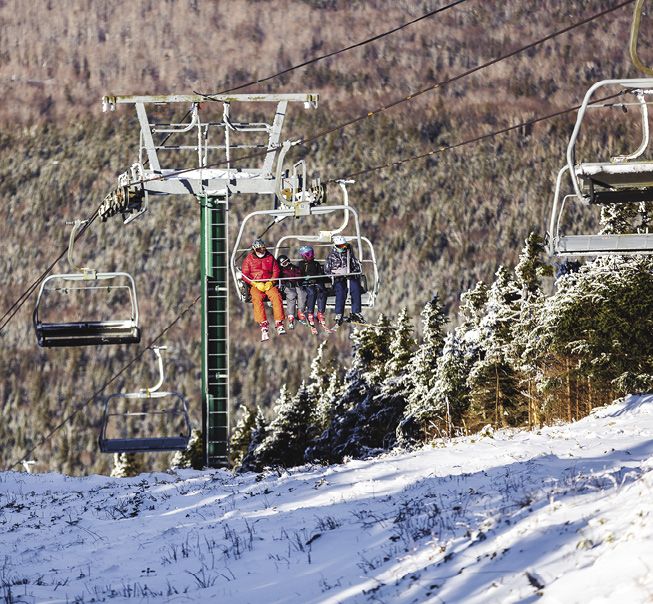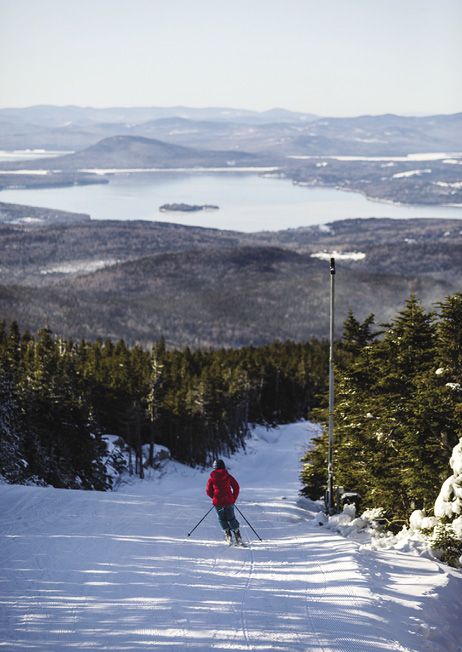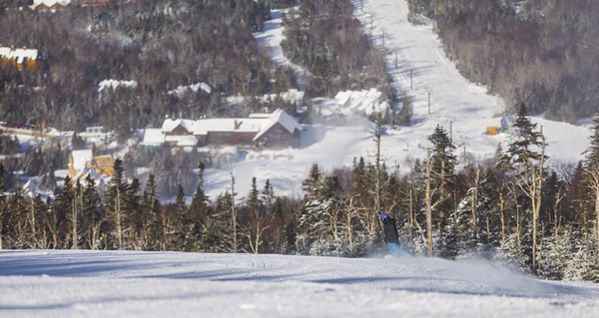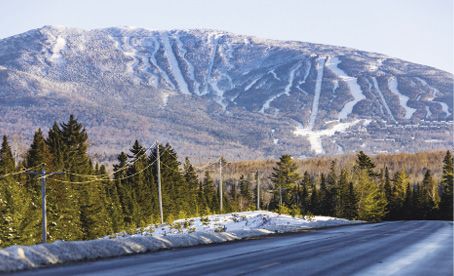SKIING HISTORY
Editor Greg Ditrinco
Consulting Editor Seth Masia
Art Director Edna Baker
Editorial Board
Seth Masia, Chairman
John Allen, Andy Bigford, John Caldwell, Jeremy Davis, Kirby Gilbert, Paul Hooge, Jeff Leich, Bob Soden, Ingrid Wicken
Founding Editors
Morten Lund, Glenn Parkinson
To preserve skiing history and to increase awareness of the sport’s heritage
ISHA Founder
Mason Beekley, 1927–2001
ISHA Board of Directors
Rick Moulton, Chairman
Seth Masia, President
Wini Jones, Vice President
Jeff Blumenfeld, Vice President
John McMurtry, Vice President
Bob Soden (Canad), Treasurer
Einar Sunde, Secretary
Richard Allen, Skip Beitzel, Michael Calderone, Art Currier, Dick Cutler, David Ingemie, Joe Jay Jalbert, Henri Rivers, Charles Sanders, Christof Thöny (Austria), Ivan Wagner (Switzerland)
Presidential Circle
Christin Cooper, Billy Kidd, Jean-Claude Killy, Bode Miller, Doug Pfeiffer, Penny Pitou, Nancy Greene Raine
Membership Services
Laurie Glover
(802) 375-1105
laurie@skiinghistory.org
Corporate Sponsorships
Peter Kirkpatrick
(541) 944-3095
peterk10950@gmail.com
Bimonthly journal and official publication of the International Skiing History Association (ISHA)
Partners: U.S. Ski and Snowboard Hall of Fame | Canadian Ski Museum and Hall of Fame
Alf Engen Ski Museum | North American Snowsports Journalists Association | Swiss Academic Ski Club
Skiing History (USPS No. 16-201, ISSN: 23293659) is published bimonthly by the International Skiing History Association, P.O. Box 1064, Manchester Center, VT 05255.
Periodicals postage paid at Manchester Center, VT and at additional mailing offices. Postmaster: Send address changes to ISHA, P.O. Box 1064, Manchester Center, VT 05255
ISHA is a 501(c)(3) public charity. EIN: 06-1347398
Written permission from the editor is required to reproduce, in any manner, the contents of Skiing History, either in full or in part.
Back in the Saddle
Shuttered for five years, Maine's Saddleback Mountain has reopened. Can it do well by doing good?
December 15, 2020, dawned cold and windy—and with the Covid-19 pandemic raging. But that didn’t stop about 300 skiers and boarders from riding the new Rangeley high-speed quad at Saddleback Mountain near Rangeley, Maine. It was the first time in five seasons that the lifts had spun at Saddleback—one of New England’s hidden gems. And more than just the ski area’s loyalists were happy. The entire region breathed a sigh of relief.

time in half, to about four minutes.
Courtesy Maine Mountain Media
“There’s been a steady stream of people who have come to me, some of them ecstatic, some of them just really emotional, about how much it means to them that the mountain is open again,” said Saddleback CEO and general manager Andy Shepard. He’s a former L.L. Bean executive who started the Maine Winter Sports Center (now Outdoor Sport Institute) to help revive the economy of Maine’s far northern Aroostook County and teach the area’s youth how to ski.
But this is more than a story of a shuttered ski area’s resurrection. In an era of mass consolidation in the ski industry, it’s a story about a new model of ski-area ownership built on the foundation of impact investing, a financial strategy, growing in popularity, aimed to deliver social benefits in addition to financial gains. In Saddleback’s case, it’s about bringing back jobs and helping the local economy, which in turn helps the local community.

round recreation. Maine Mountain
Media
When Saddleback opened on New Year’s Eve 1960—with a 4,120-foot summit and the highest base elevation in New England—the owners envisioned the resort becoming the “Sun Valley of the East.” It promised 2,000 vertical feet of skiing, 200 inches of snow annually, and stunning views of the Rangeley Lakes region—the lakes themselves offer four-season recreation. But the lofty ideal was never achieved. The secluded resort—a three-hour drive from Portland and four-plus hours from Boston—was perhaps too secluded, especially with limited lodging in the area. During Saddleback’s first 18 years, it had five owners.
In 1978, Donald Breen, a Massachusetts businessman, came along with plans to revive the ski area. But the Appalachian Trail corridor runs across Saddleback’s above-timberline summit, and Breen spent almost two decades battling the National Park Service over access rights to the trail corridor. By the time Breen and the NPS came to an agreement in 2000, the battle had derailed Breen’s expansion plans. He sold the area for $8 million to retired University of Maine geologist Bill Berry and his wife, Irene, in 2003.
For a decade, the Berrys ran Saddleback as a labor of love, improving snowmaking, enlarging the base lodge, adding more expert terrain, and replacing a vertiginous T-bar with a chairlift. Saddleback has always had a devoted community of skiers—“a sense of family that I have not experienced, and I’ve been in this business for a long time,” noted Shepard. Saddleback patrons included locals and part-time residents alike, with nary a distinction between them—unlike the contentious vibe between the two groups at many large resorts. Skier visits climbed steadily.

joined by a planned mid-mountain
lodge. Maine Mountain Media.
But the Berrys had to weather the Great Recession (2007-2009), and Saddleback lacked a high-speed chairlift—an amenity that has become a standard resort convenience, even at modest ski areas. As a result, annual skier visits began to decline.
Unwilling to invest further capital, the Berrys put Saddleback on the market for $12 million in December 2012. But no buyers came forth. Three years later, they announced that if they could not acquire $3 million in funding for a new chairlift, they would not open for the season.
Potential buyers came and went over the next four years, including a group of Saddleback faithful who wanted to operate the mountain as a nonprofit Mad River Glen-like co-op. Then came a shyster from Australia proposing an EB-5 Ponzi scheme similar to the failed debacle at Vermont’s Jay Peak. “The community was put through the wringer, hopes raised and dashed on a regular basis,” said Shepard.
Locals and Saddleback fans had almost given up hope when Shepard’s group rode in on a white horse. Or rather a horse of a different color. Knowing how important Saddleback was to the Rangeley community, Shepard had been working with the Berrys since 2014 to secure a suitable buyer. And with his experience founding the Maine Winter Sports Center, Shepard knew that the mountain was as important an economic driver to the Rangeley region as the Sports Center was to Aroostook County.
He knew Saddleback could be profitable—but only if someone would first inject millions of dollars into the infrastructure. But who was going to invest that kind of money in an out-of-the-way ski area and in an industry that is susceptible to climate change? A traditional investor looking for private equity-style returns would look elsewhere. The state's Department of Economic and Community Development knew where to look. Early in 2018, they brought in Boston-based Arctaris Impact Fund, which has been investing in projects in the Rust Belt and other economically disadvantaged areas for more than a decade. Arctaris leverages non-traditional impact investors and nonprofit foundations that are motivated by making a societal difference and will settle for smaller returns, New Markets Tax Credits, state-guaranteed loans, and support from the community and local foundations. Saddleback fit the profile.
It took two years to close the agreement, but Arctaris purchased Saddleback on January 31, 2020, for $6.5 million, with a plan to invest $38 million over the next five years in new lifts, base lodge refurbishment, a new mid-mountain lodge, a solar array to power the mountain, a hotel, daycare center, employee housing, and other modern resort necessities.
Arctaris co-founder Jonathan Tower sees the deal as a chance to revitalize a region hit hard by Saddleback’s closing. “This is about more than opening a mountain,” said Tower. “This is about restoring 200-plus jobs to the community. It’s about the regional economic impact of Saddleback. And it’s about the health and wellness benefits of an operational mountain.”
With negotiations complete, Arctaris asked Shepard to become Saddleback’s CEO and general manager. Shepard was especially attracted to the deep connection between mountain and community. “It’s more than a ski area,” he said. “It’s been a family to people. There’s a deep sense of responsibility that goes along with that. Knowing that we’re stewards of that kind of connection is important to me. I’ve tried to make sure we build an organization of people to whom that’s equally important.”
Both the pandemic and the regional economy made Saddleback’s first season a challenge. Many people who once worked at Saddleback have moved away, so the hiring pool is smaller than it once was. But Shepard is confident that workers will be lured back by competitive wages, a creative program to provide year-round benefits like health insurance to seasonal workers, and the soon-to-be-built employee housing and daycare center.
Saddleback’s modest pass prices for youth and elders is another nod to the community. Purchase a season pass in the spring and prices range from $30 (under 6) to $50 for local students to $30 for a super senior pass (80 and over)—a pass category that is no longer offered at most resorts. In addition, all passes can be purchased under an installment plan.
Shepard is equally confident that the new Rangeley high-speed quad, which cut the 11-minute ride time by more than half, a refurbished base lodge, and a planned mid-mountain lodge atop the quad will attract more skiers to Saddleback. The mid-mountain lodge will have views west to New Hampshire’s Mount Washington and a flat roof planted with sod and blueberry bushes so that the building is largely hidden from across the ridgeline.
When new skiers and riders discover Saddleback, Shepard hopes that they will integrate into the community, as has happened for generations. “People care for one another here,” he explained. “There’s very little judgment about political opinions and who’s got money and who doesn’t. It’s just people who love Saddleback, people who love doing things with family and friends.” 
Table of Contents

Corporate Sponsors
ISHA deeply appreciates your generous support!
WORLD CHAMPIONSHIP ($3,000 AND UP)
Gorsuch
Polartec
CHAMPIONSHIP ($2,000)
Fairbank Group: Bromley, Cranmore, Jiminy Peak
Hickory & Tweed Ski Shop
WORLD CUP ($1,000)
Aspen Skiing Company
Bogner
Boyne Resorts
Dale of Norway
Darn Tough Vermont
Dynastar | Lange | Look
Gordini USA Inc. | Kombi LTD
HEAD Wintersports
Intuition Sports, Inc.
Mammoth Mountain
Marker-Volkl USA
National Ski Areas Association
Outdoor Retailer
Rossignol
Ski Area Management
Ski Country Sports
Snowsports Merchandising Corporation
Sport Obermeyer
Sports Specialists, Ltd.
Sun Valley Resort
Vintage Ski World
Warren and Laurie Miller
Yellowstone Club
GOLD ($700)
Larson's Ski & Sport
Race Place | BEAST Tuning Tools
The Ski Company (Rochester, NY)
Thule
SILVER ($500)
Alta Ski Area
Boden Architecture PLLC
Dalbello Sports
Deer Valley
Ecosign Mountain Resort Planners
Fera International
Holiday Valley
Hotronic USA, Inc. | Wintersteiger
MasterFit Enterprises
McWhorter Driscoll, LLC
Metropolitan New York Ski Council
Mt. Bachelor
New Jersey Ski & Snowboard Council
Russell Mace Vacation Homes
Schoeller Textile USA
Scott Sports
Seirus Innovations
SeniorsSkiing.com
Ski Utah
Steamboar Ski & Resort Corporation
Swiss Academic Ski Club
Tecnica Group USA
Timberline
Trapp Family Lodge
Western Winter Sports Reps Association
World Pro Ski Tour


